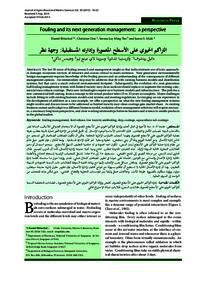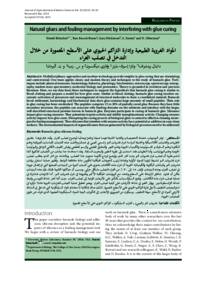Document
Fouling and its next generation management: a perspective.
Contributors
Publisher
جامعة السلطان قابوس. كلية العلوم الزراعية والبحرية
Gregorian
2015
Language
English
Subject
English abstract
The last 50 years of fouling research and management taught us that indiscriminate use of toxic approaches damages ecosystem services of estuaries and oceans critical to man's existence. Next generation environmentally benign management requires knowledge of the fouling process and an understanding of the consequences of different management options. An intermediate step may be additives that fit with existing business models and distribution systems, but that carry a much reduced environmental footprint. Subsequently, the evolution of a next generation hull fouling management system with limited toxicity easy clean surfaces should replace or augment the existing commercial easy-release coatings. These new technologies require new business models and infrastructure. The path for a new commercial hull coating, from a concept to the actual product takes 25 to 35 years to complete. Major challenges include fitting in with existing business models and systems and meeting regulations. Leveraging on our experience in the development of additives as a case example, we offer a perspective on what the new fouling management systems might involve and discuss issues to be addressed as limited toxicity easy-clean coatings gain market share. As existing business cannot easily adapt to a different business model, evolution of new management solutions will require resources, a necessary long term perspective, and close working relationships between business and science to enable products in the global market.
Member of
ISSN
2410-1079
Resource URL
Citation
Rittschof, D., Chai, Ch., Teo, S. L. M., & Maki, J. S. (2015). Fouling and its next generation management: a perspective. Agricultural and Marian Sciences Journal, 20 (1), 16-23.
Arabic abstract
علمتنا ال50 سنة الأخيرة في مجال أبحاث وإدارة التراكم الحيوي على الأسطح المغمورة أن الاستخدام العشوائي للأساليب السامة تضر بالخدمات البيئية لمصبات الأنهار والمحيطات، تلك الخدمات الأساسية لوجود الإنسان. إن الجيل القادم من الإدارة غير الضارة بالبيئة يتطلب معرفة بعملية التراكم الحيوي على الأسطح المغمورة، وفهما لتبعات الخيارات الإدارية المختلفة. يمكن أن تكون المضافات الصناعية، التي تنسجم مع نماذج إدارة الأعمال ومع أنظمة التوزيع ولها أثر بيئي منخفض، خطوة وسطية نحو تلك الإدارة المستقبلية. وتبعا لذلك، فإن تطوير جيل قادم من نظام إدارة عملية التراكم على الأسطح لبدن السفن، تكون سمته محدودة و له خاصية التنظيف السهل للأسطح، سيحتم استبدال أو دعم الطلاءات التجارية الحالية السهلة الإزالة. هذه التقنيات الجديدة تتطلب نماذج وبنية تحتية جديدة لإدارة الأعمال، كما أن الدرب لتصنيع طلاء تجاري لبدن السفن، من مرحلة التصور إلى المنتج الحقيقي، ستستغرق 25 إلى 35 عاما. تشمل التحديات الرئيسية انسجام النماذج والأنظمة الحالية لإدارة الأعمال والتماشي مع القوانين. اعتمادا على خبرتنا في تطوير المضافات كمثال عملي، نقدم رؤيتنا حول ما ستشمله أنظمة إدارة التراكم الحيوي على الأسطح المغمورة، ونناقش مسائل يجب الالتفات إليها مع زيادة الحصة السوقية للطلاءات ذات السمية المحدودة والسهلة التنظيف. وبما أن إدارة الأعمال الحالية لا تستطيع أن تتأقلم بسهولة مع نموذج مختلف لإدارة الأعمال، فإن تطوير حلول إدارية جديدة سيتطلب موارد، ورؤية ستكون بالضرورة طويلة الأمد، وعلاقات عمل وثيقة بن المؤسسات التجارية والقطاع العلمي، حتى نمكن هذه المنتجات من التواجد في السوق العالمية.
Category
Journal articles


